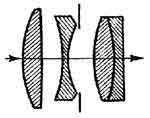

 |
 |
| Finder opened | Finder closed |
This Kodak 35 is the first 35mm format camera produced by the Eastman Kodak company. I was interested in its robust outlook and simplified specs introduced in a book. The lens looks very big in comparison with usual 35 mm cameras. This is because the lens and shutter unit of former Brownie sized bellows cameras is simply brought to fit 35mm camera body. For its origin of tinkering of existing parts, mechanical link between the lens and body is good. It is self-cocking (the shutter is set simultaneously with film winding) and there is an indicater that shows whether the film was wound. The button on the body is not the shutter release, but the release of the stopper of winding. You release the shutter with a lever on the side of the lens and then push this button and wind the film. These mechanisms work together and prevent double exposure and winding without exposure. Very logical design. The finder is usually collapsed and lift-up manually before use. When you bring a camera with a neck strap, the finder soon gets cloudy because of your body moisture, but with this camera no such thing happens. Fitted for outdoor activity. The body is made of Bakelite (classic synthetic resin). There is no covering with leather, thus free from its cracking and getting fungus. The bakelite is very thick and sturdy. The body shape is rounded on both ends, something looks like early Leica cameras.
 |
| The bottom and back removed |
The back and bottom is removed together, enabling easy film exchange. The design looks like Russian FED-2 camera. Another similarity is that there is no leather covering on FED-2, too. FED-2 is manufactured later than Kodak35, so FED may be influenced by the Kodak design. The indication of the lock dial only shows "open" when closed and shows "lock" when opened, simple and clever design. Inside, there is a glittering plated pressure plate. Modern cameras usually have black painted plate, but somehow Kodak of this period preferred shiny plates. The design of the label on the film chamber is reminiscent of good-old days. Winding gears are made of shining stainless steel and very robust, never breaks. When the film is wound, these heavy sprocket gears are turned and then the force is linked to shutter mechanisms and the shutter is set. When there is no film inside, you have to turn the gears with your fingers to set the shutter. The gear is heavy and pointed, so it hurts fingers. It reminds me how strong the film is against tensile force.
 |
 |
 |
| Dial of the back door lock | Nice looking label | Heavy gears made of stainless steel |
 |
| When the small botton pointing forward is pushed, the pressure plate moves slightly toward the lens |
Another interesting thing with the back door is that there is a mechanism at the pressure plate, enabling that the plate is strongly pressed against the film when the door is closed, but the pressure weakens as the door is opend. The Brownie film is covered with black paper on its back, but the 35 mm film is naked. The designer may have considered this and tried to reduce the chance of scratching the film. Regardless of its practical effectiveness, I appreciate the care of the designer.
 |
| The shutter with a good name |
May be I have talked over the back door too long. One of the reason why I liked this camera was because of the name of its shutter. My family name is seldom used in a brand name, so this is a precious example. The shutter with the same name is also used previous bellows cameras. Of course, it is derived from the brand name "Kodak". I, then, wondered how the name Kodak is born. According to the Kodak web page, there is no special meaning in this name but it was chosen by the founder Geoge Eastman because it has a good crisp sound. The shutter is very quiet somewhat seems unreliable, but it works. The self timer is out of order.
 |
| Kodak Anastigmat Special 50mm f3.5 Object to the left, film to the right |
The lens is named Kodak Anastigmat Special 50mm f3.5. The serial number beginning from EY indicates that this lens was manufactured in 1940. It was a little cloudy inside after 60 years, but it was easily cleaned. The lens is without coating, but still gives crisp images. The diagram on the left is taken from a panflet from Kodak. It resembles the Tessar from Zeiss with a difference that rear two lenses are in reverse order. The high quality camera Ektra, which was manufactured in the same time period, has an exchange lens Ektar 50mm f3.5, whose diagram resembles this Anastigmat lens. How the Ektar 50mm f3.5 on Retina cameras, also in the similar time period, was designed? I have not yet seen its diagram.
According to a guide book, the Kodak 35 with these lens and shutter was produced from 1938 until 1948 and sold at $40. A little later, the Argus company in US sold the Argus C with a range finder at $25. This made Kodak to add a range finder to the Kodak 35. The model with a range finder is often found in the auction, but its design is ....ugly, covered with gears and levers on its lens and big range finder on its top.
Cameras without exposure meter and range finder like this Kodak 35 are cheap and less vulnerable, making trade on the internet auction easy. I had collected a few of them afterward. Modern films and printing labos are of so good quality that we can get nice prints out of these cameras easily. How about getting one of them and try by yourself?
 |
written on 28 June, 2000